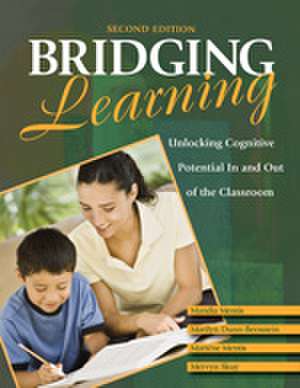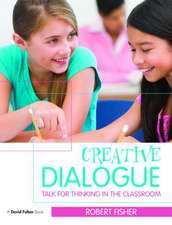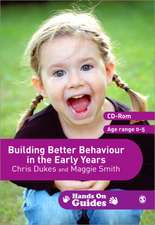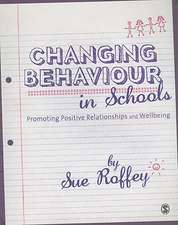Bridging Learning: Unlocking Cognitive Potential In and Out of the Classroom
Editat de Mandia Mentis, Marilyn Dunn-Bernstein, Martene Mentis, Mervyn Skuyen Limba Engleză Paperback – 27 iul 2009
'Using real-world examples and applications, this book makes cognitive psychology and cognitive education accessible to all who work with children and other learners. I immediately felt more confident in applying my new thinking and understanding to my practice'—Wendy Holley, School Psychologist, Bend-La Pine School District, OR
Based on Instrumental Enrichment (IE), a cognitive education approach pioneered by internationally renowned psychologist and child development expert Reuven Feuerstein, this updated volume provides practitioners with much-needed techniques to develop students' thinking skills and "bridge" these skills to the home and community.
This user-friendly book outlines fourteen core thinking skills that increase students' cognitive capacity, including organization, comparison, categorization, and problem solving. The authors demonstrate how teachers can mediate learning in the classroom and help parents, social workers, counsellors, and other adults who work with youth to extend learning beyond the classroom. Each chapter features:
- An introduction to and description of a specific skill
- Examples and applications for formal and informal learning contexts
- An outline of how the skill aligns with Feuerstein's theories of Mediated Learning and Cognitive Modifiability
Expanded to include an overview of many IE-related research studies and quotes to stimulate reflection on each skill, this second edition of Bridging Learning is a dynamic resource for creative educators dedicated to enhancing thinking skills in all learners.
| Toate formatele și edițiile | Preț | Express |
|---|---|---|
| Paperback (1) | 283.58 lei 6-8 săpt. | |
| SAGE Publications – 27 iul 2009 | 283.58 lei 6-8 săpt. | |
| Hardback (1) | 485.13 lei 6-8 săpt. | |
| SAGE Publications – 23 iun 2009 | 485.13 lei 6-8 săpt. |
Preț: 283.58 lei
Nou
Puncte Express: 425
Preț estimativ în valută:
54.26€ • 56.81$ • 44.90£
54.26€ • 56.81$ • 44.90£
Carte tipărită la comandă
Livrare economică 05-19 aprilie
Preluare comenzi: 021 569.72.76
Specificații
ISBN-13: 9781412969956
ISBN-10: 1412969956
Pagini: 152
Dimensiuni: 216 x 279 x 10 mm
Greutate: 0.43 kg
Ediția:Second Edition
Editura: SAGE Publications
Colecția Corwin
Locul publicării:Thousand Oaks, United States
ISBN-10: 1412969956
Pagini: 152
Dimensiuni: 216 x 279 x 10 mm
Greutate: 0.43 kg
Ediția:Second Edition
Editura: SAGE Publications
Colecția Corwin
Locul publicării:Thousand Oaks, United States
Recenzii
"A practical and useful resource. Covers 14 specific thinking skills, explains why each skill is important, and describes when and where we use it. The book presents strategies for use in school and gives bridging activities to use at home and in the community."
"This book seamlessly blends theory with practical, real-life applications and activities that can be completed quickly and easily in both school and home/community settings. This encourages a partnership between all stakeholders to help students succeed."
"The idea that cognitive potential can be unlocked has become a powerful and influential idea in all sectors of education, be it early childhood education or higher education. This book consists of a series of activities framed by the most up-to-date thinking and research on cognition and mediation. The book makes available to parents, teachers, caregivers, community workers, and counselors a thought-provoking stance on thinking and learning and easy-to-apply techniques for getting it right."
"Using real-world examples and applications, this book makes cognitive psychology and cognitive education accessible to all those who work with children and other learners. The format is easy to follow, as the authors explore one key cognitive strategy in each chapter. I immediately felt more confident in applying my new thinking and understanding to my practice."
"A valuable companion text for educators and others utilizing Reuven Feuerstein's programs and methods for the teaching of thinking. The authors provide practical examples and clearly illustrate how to effectively mediate each of the fourteen areas of thinking identified by Feuerstein."
"Effective learning of thinking strategies and skills requires inspired bridging to meaningful examples. The authors share exciting up-to-date examples, particularly for bridging generally to all learning, to personal and community health, and to technology."
"This book seamlessly blends theory with practical, real-life applications and activities that can be completed quickly and easily in both school and home/community settings. This encourages a partnership between all stakeholders to help students succeed."
"The idea that cognitive potential can be unlocked has become a powerful and influential idea in all sectors of education, be it early childhood education or higher education. This book consists of a series of activities framed by the most up-to-date thinking and research on cognition and mediation. The book makes available to parents, teachers, caregivers, community workers, and counselors a thought-provoking stance on thinking and learning and easy-to-apply techniques for getting it right."
"Using real-world examples and applications, this book makes cognitive psychology and cognitive education accessible to all those who work with children and other learners. The format is easy to follow, as the authors explore one key cognitive strategy in each chapter. I immediately felt more confident in applying my new thinking and understanding to my practice."
"A valuable companion text for educators and others utilizing Reuven Feuerstein's programs and methods for the teaching of thinking. The authors provide practical examples and clearly illustrate how to effectively mediate each of the fourteen areas of thinking identified by Feuerstein."
"Effective learning of thinking strategies and skills requires inspired bridging to meaningful examples. The authors share exciting up-to-date examples, particularly for bridging generally to all learning, to personal and community health, and to technology."
Cuprins
Preface
Acknowledgments
About the Authors
Introduction
1. Organization
Organization: What, Why, When, and Where?
Bridging Organization to Formal Learning Concepts
Bridging Organization to Informal Learning Concepts
Application of Organization: Energy Efforts
Feuerstein's Theory in Mediating Organization
2. Comparisons
Comparisons: What, Why, When, and Where?
Bridging Comparisons to Formal Learning Contexts
Bridging Comparisons to Informal Learning Contexts
Application of Comparison: Cyber Counseling
Feuerstein's Theory in Mediating Comparison
3. Categorization
Categorization: What, Why, When, and Where?
Bridging Categorization to Formal Learning Contexts
Bridging Categorization to Informal Learning Contexts
Application of Categorization: Toys and Tots
Feuerstein's Theory in Mediating Categorization
4. Relational Orientation in Space
Relational Orientation in Space: What, Why, When, and Where?
Bridging Relational Orientation in Space to Formal Learning Contexts
Bridging Relational Orientation in Space to Informal Learning Contexts
Application of Relational Orientation in Space: Family Feuds
Feuerstein's Theory in Mediating Relational Orientation in Space
5. Cardinal Orientation in Space
Cardinal Orientation in Space: What, Why, When, and Where?
Bridging Cardinal Orientation in Space to Formal Learning Contexts
Bridging Cardinal Orientation in Space to Informal Learning Contexts
Application of Cardinal Orientation in Space: Cultural Compass
Feuerstein's Theory in Mediating Cardinal Orientation in Space
6. Analysis and Synthesis
Analysis and Synthesis: What, Why, When, and Where?
Bridging Analysis and Synthesis to Formal Learning Contexts
Bridging Analysis and Synthesis to Informal Learning Contexts
Application of Analysis and Synthesis: Think Global, Act Local
Feuerstein's Theory in Mediating Analysis and Synthesis
7. Problem Solving
Problem Solving: What, Why, When, and Where?
Bridging Problem Solving to Formal Learning Contexts
Bridging Problem Solving to Informal Learning Contexts
Application of Problem Solving: Cyber Bullies and Suicide Scripts
Feuerstein's Theory in Mediating Problem Solving
8. Relationships
Relationships: What, Why, When, and Where?
Bridging Relationships to Formal Learning Contexts
Bridging Relationships to Formal Learning Contexts
Application of Relationships: Relatives and Relations
Feuerstein's Theory in Mediating Relationships
9. Temporal Concepts
Temporal Concepts: What, Why, When, and Where?
Bridging Temporal Concepts to Formal Learning Contexts
Bridging Temporal Concepts to Informal Learning Contexts
Application of Temporal Concepts: Slow and Steady
Feuerstein's Theory in Mediating Temporal Concepts
10. Instructions
Instructions: What, Why, When, and Where?
Bridging Instructions to Formal Learning Contexts
Bridging Instructions to Informal Learning Contexts
Application of Instructions: Implied Instruction
Feuerstein's Theory in Mediating Instructions
11. Progressions
Progressions: What, Why, When, and Where?
Bridging Progressions to Formal Learning Contexts
Bridging Progressions to Informal Learning Contexts
Application of Progressions: Cultural Constants and Continuities
Feuerstein's Theory in Mediating Progressions
12. Transitive Relations
Transitive Relations: What, Why, When, and Where?
Bridging Transitive Relations to Formal Learning Contexts
Bridging Transitive Relations to Informal Learning Contexts
Application of Transitive Relations: Global Greed
Feuerstein's Theory in Mediating Transitive Relations
13. Syllogisms
Syllogisms: What, Why, When, and Where?
Bridging Syllogisms to Formal Learning Contexts
Bridging Syllogisms to Informal Learning Contexts
Application of Syllogisms: Silly Syllogism
Feuerstein's Theory in Mediating Syllogisms
14. Scaffolding
Scaffolding: What, Why, When, and Where?
Bridging Scaffolding to Formal Learning Contexts
Bridging Scaffolding to Informal Learning Contexts
Application of Scaffolding: Project Planning
Feuerstein's Theory in Mediating Scaffolding
Appendix A: 12 Criteria of a Mediated Learning Experience (MLE)
Appendix B: Cognitive Functions and Dysfunctions
Appendix C: Cognitive Map
Glossary
References
Index
Acknowledgments
About the Authors
Introduction
1. Organization
Organization: What, Why, When, and Where?
Bridging Organization to Formal Learning Concepts
Bridging Organization to Informal Learning Concepts
Application of Organization: Energy Efforts
Feuerstein's Theory in Mediating Organization
2. Comparisons
Comparisons: What, Why, When, and Where?
Bridging Comparisons to Formal Learning Contexts
Bridging Comparisons to Informal Learning Contexts
Application of Comparison: Cyber Counseling
Feuerstein's Theory in Mediating Comparison
3. Categorization
Categorization: What, Why, When, and Where?
Bridging Categorization to Formal Learning Contexts
Bridging Categorization to Informal Learning Contexts
Application of Categorization: Toys and Tots
Feuerstein's Theory in Mediating Categorization
4. Relational Orientation in Space
Relational Orientation in Space: What, Why, When, and Where?
Bridging Relational Orientation in Space to Formal Learning Contexts
Bridging Relational Orientation in Space to Informal Learning Contexts
Application of Relational Orientation in Space: Family Feuds
Feuerstein's Theory in Mediating Relational Orientation in Space
5. Cardinal Orientation in Space
Cardinal Orientation in Space: What, Why, When, and Where?
Bridging Cardinal Orientation in Space to Formal Learning Contexts
Bridging Cardinal Orientation in Space to Informal Learning Contexts
Application of Cardinal Orientation in Space: Cultural Compass
Feuerstein's Theory in Mediating Cardinal Orientation in Space
6. Analysis and Synthesis
Analysis and Synthesis: What, Why, When, and Where?
Bridging Analysis and Synthesis to Formal Learning Contexts
Bridging Analysis and Synthesis to Informal Learning Contexts
Application of Analysis and Synthesis: Think Global, Act Local
Feuerstein's Theory in Mediating Analysis and Synthesis
7. Problem Solving
Problem Solving: What, Why, When, and Where?
Bridging Problem Solving to Formal Learning Contexts
Bridging Problem Solving to Informal Learning Contexts
Application of Problem Solving: Cyber Bullies and Suicide Scripts
Feuerstein's Theory in Mediating Problem Solving
8. Relationships
Relationships: What, Why, When, and Where?
Bridging Relationships to Formal Learning Contexts
Bridging Relationships to Formal Learning Contexts
Application of Relationships: Relatives and Relations
Feuerstein's Theory in Mediating Relationships
9. Temporal Concepts
Temporal Concepts: What, Why, When, and Where?
Bridging Temporal Concepts to Formal Learning Contexts
Bridging Temporal Concepts to Informal Learning Contexts
Application of Temporal Concepts: Slow and Steady
Feuerstein's Theory in Mediating Temporal Concepts
10. Instructions
Instructions: What, Why, When, and Where?
Bridging Instructions to Formal Learning Contexts
Bridging Instructions to Informal Learning Contexts
Application of Instructions: Implied Instruction
Feuerstein's Theory in Mediating Instructions
11. Progressions
Progressions: What, Why, When, and Where?
Bridging Progressions to Formal Learning Contexts
Bridging Progressions to Informal Learning Contexts
Application of Progressions: Cultural Constants and Continuities
Feuerstein's Theory in Mediating Progressions
12. Transitive Relations
Transitive Relations: What, Why, When, and Where?
Bridging Transitive Relations to Formal Learning Contexts
Bridging Transitive Relations to Informal Learning Contexts
Application of Transitive Relations: Global Greed
Feuerstein's Theory in Mediating Transitive Relations
13. Syllogisms
Syllogisms: What, Why, When, and Where?
Bridging Syllogisms to Formal Learning Contexts
Bridging Syllogisms to Informal Learning Contexts
Application of Syllogisms: Silly Syllogism
Feuerstein's Theory in Mediating Syllogisms
14. Scaffolding
Scaffolding: What, Why, When, and Where?
Bridging Scaffolding to Formal Learning Contexts
Bridging Scaffolding to Informal Learning Contexts
Application of Scaffolding: Project Planning
Feuerstein's Theory in Mediating Scaffolding
Appendix A: 12 Criteria of a Mediated Learning Experience (MLE)
Appendix B: Cognitive Functions and Dysfunctions
Appendix C: Cognitive Map
Glossary
References
Index
Descriere
This updated volume provides fourteen core thinking skills that increase students' cognitive capacity and shows educators how to "bridge" these skills to the home and community.









